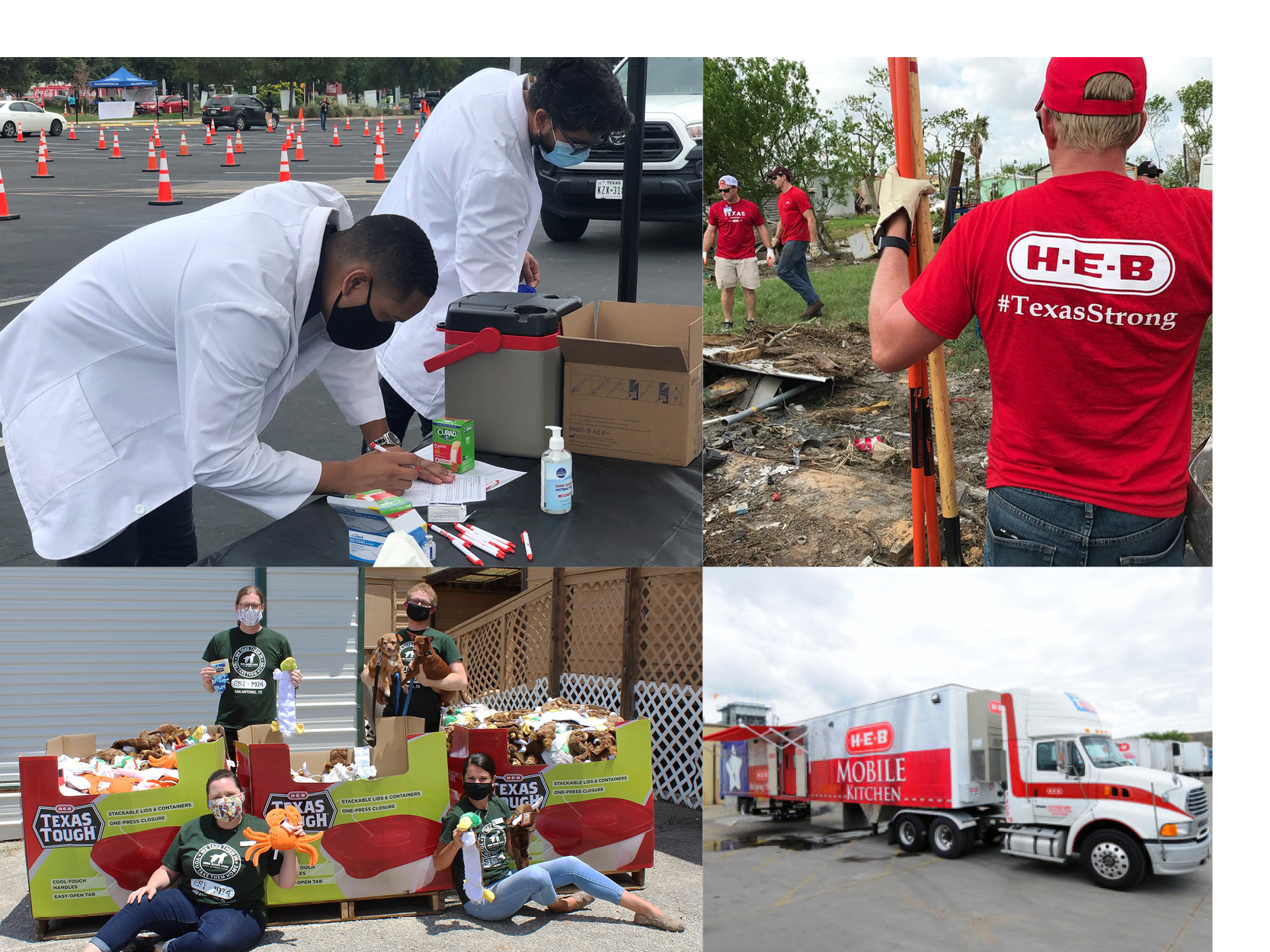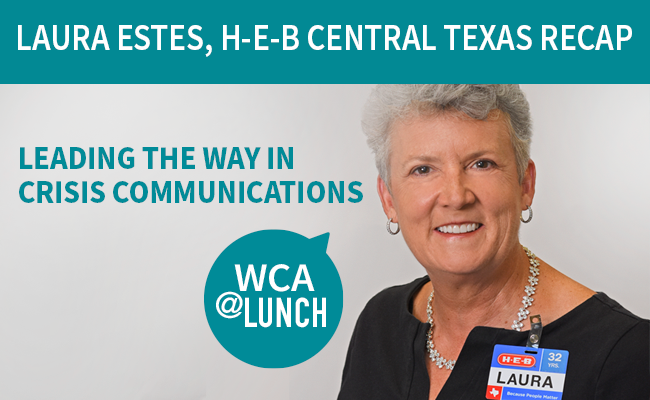
by Dianne Campbell, a marketing and communications professional at the Texas Association for School Boards

Here in Central Texas, H-E-B continues to be a community leader during any disaster Texans face. So how does H-E-B work behind the scenes to provide the support we see?
Our November 2020 WCA@Lunch welcomed Laura Estes, Director of Marketing and Merchandising of Central Texas H-E-B, She was joined by Leslie Sweet, Director of Public Affairs for H-E-B, and together the two discussed H-E-B’s history, its approach to crisis management and communications, and why their employees are at the heart of their success. The hour-long discussion showcased how crisis communications can become not only a part of a brand, but a part of a community.
The conversation was moderated by Anne Lasseigne Tiedt, our WCA VP of Programs, and the Zoom luncheon had 50 engaged participants.. Here are our favorite takeaways on crisis management and communication from the insightful presentation by the company that just one month after the luncheon was named the top U.S. grocery retailer.
Take Care of People and Build Them to Become Great Leaders
Laura described herself as an “operations girl at heart” whose job is to support marketing efforts and 55 H-E-B stores across Central Texas. She started working part-time at H-E-B in 1984, while finishing her BBA at The University of Texas Austin. Although she never intended to make her career at H-E-B, she never looked back. According to Laura, H-E-B takes great care of its people and transforms them into leaders. It’s a truly compelling experience for Laura; starting out as a cashier in 1984, being a management trainee in 1986, serving as a director for 10 years to now supporting 55 stores and over 17,000 partners working in these stores. “I have drunk the Kool-Aid and now I deeply care about our partners, customers, shoppers, and H-E-B community,” Laura says.
Develop Amazing People Who Will Embody the Company Spirit and Values
To start the conversation, Laura gave our attendees insight into what makes H-E-B the special place that it is. Some attendees were surprised to know H-E-B was started by a woman. Florence opened the first store in 1905 in Kerrville, TX. The company that started with $60 in South Texas is now a $27 Billion dollar company with a 115-year history, operating 400 stores, nine Central Markets, nine Joe V’s Smart Shop, # Mi Tiendas, 13 manufacturing plants, 17 warehouses, a partnership with Favor, and approximately 120,000 partners across Texas and Mexico. However, what makes H-E-B powerful are its amazing partners that embody what is known as the “spirit of H-E-B” and adhere to H-E-B’s bold promise. Since 1996, H-E-B has centered everything it does around it’s bold promise to build the greatest retail company so that they can make people’s lives better. In times of crisis, working with partners and staying focused on this bold promise helps H-E-B to be successful. Laura describes H-E-B as a “people business that happens to sell groceries” to fund making communities better.
Prepare to Manage Exposure to Any Crises
Although living through the pandemic has been unprecedented, H-E-B has faced and handled many crises prior to COVID-19. They have experienced hurricanes, tornadoes, flooding, power outages, fires, water main breaks, water contaminations, water shortages, hailstorms, pandemics and more. However, H-E-B is prepared to manage exposure to any of these crises. So how do they address these risks? What are their keys to success for emergency preparedness? They have a business continuity plan for catastrophic incident management, emergency preparedness community, government liaisons, an emergency operation center (EOC), and tons of emergency assets. From their multi-day planning scenarios to their Slack channels that deliver frontline information directly to stores, H-E-B soars in crisis.
Include a Variety of Leaders and Talent from Across the Organization at the Planning Table
Some of their emergency assets include generators, water tankers, mobile pharmacies, mobile kitchens, and a disaster response unit. Activation of H-E-B’s EOC is a key step in their crisis management plan because they include top leaders from the company and talent from all departments that are affected by the business disruption. Although these resources are often used to help others in the community as needed, H-E-B’s top priorities are always partner safety, keeping stores open if they can, then lend support to the community. To support the community, H-E-B also maintains strong relationships with partners at the city, county, and state levels.
Engage Through a Variety of Communication Methods
To ensure preparation for different emergencies, H-E-B uses a variety of different mediums to communicate their messages. From weather monitoring to crisis communication and text messaging tools, they use all types of channels. The H-E-B newsroom serves as the central news hub, delivering information with accurate tone and accuracy in messaging. All other channels use the newsroom as their source of content, including social media and internal channels. Ready H-E-B, an everyday emergency and safety site is used for internal communications with partners and serves as the main crisis communications mechanism. On an ongoing basis, H-E-B offers incentives for people to use and respond to messages sent through Ready H-E-B. This ensures that partners use and respond to the system frequently, especially during moments of crisis.
Although digital communication was used heavily throughout the pandemic, H-E-B also went “old school” to get their messages out. Physical signage, stickers on the ground, flyers, and entryway banners were used at stores to communicate during COVID-19, because the situation required limited verbal communication. The two speakers stressed: the important thing to remember with crisis communications is to be flexible, keep an open mind, and be ready to use all tools that would be best in getting your message out during a crisis.
Practice to Be Prepared
Beyond having the right resources to get their partners and communities through times of crisis, H-E-B continuously engages in planning sessions, training exercises, and real-world event simulations. One of their most successful strategies is conducting “tabletop exercises.” They run entire exercises as if they were happening in the real world, then conduct post-exercise assessments to determine areas for improvements. This is exactly what H-E-B did in January 2020, when they first heard about COVID-19 and its effects in Wuhan, China. With several tabletop exercises under their belt, H-E-B was ready when the pandemic reached the U.S. in March 2020.
Stay True to Who You Are and What You Believe in Times of Crisis
By staying true to who they are and what they believe, the company was able to establish trust, make decisions quickly, and tackle problems as they arose throughout the pandemic. As COVID-19 progressed in the U.S., H-E-B moved in unison, implementing measures to keep their partners safe, keep stores open, and assist their communities, as needed.
Early in the crisis they implemented initiatives such as social distancing, wearing masks , and sanitizing carts to protect their partners and customers. With the help of the H-E-B Public Affairs team, H-E-B provided a variety of support to their surrounding communities as well.
Some of these initiatives included providing meals to 80,000 frontline workers, developing a program with Favor to help the elderly to get their groceries, connecting employees with young children with appropriate resources, partnering with local boys and girls clubs to care for the children of frontline workers, delivering flowers to nurses, and they sent 300 trucks of food to Texas food banks.
When supplies were low and H-E-B could no longer provide food directly to partners like Austin ISD, they donated $100,000 to help feed school children and their families. Local restaurants that were forced to close their doors were invited to come and sell their food inside H-E-B stores, free of charge.
Serving people is at the heart of what H-E-B does. By always focusing on making life better for their partners, customers, and communities, H-E-B is prepared to navigate its way through any crisis. Laura encouraged us to do the same in our own organizations by remaining true to who we are and living our values.
ABOUT THE AUTHOR
Dianne Campbell is a marketing and communications professional with several years of experience in education marketing. She currently works as a marketing and communications specialist at the Texas Association for School Boards.
- H-E-B: Leading the Way in Crisis Communications - February 17, 2021
- Lead with Inclusion - October 14, 2020
- 2019-2020 Proposed Board of Directors Slate - April 1, 2019

